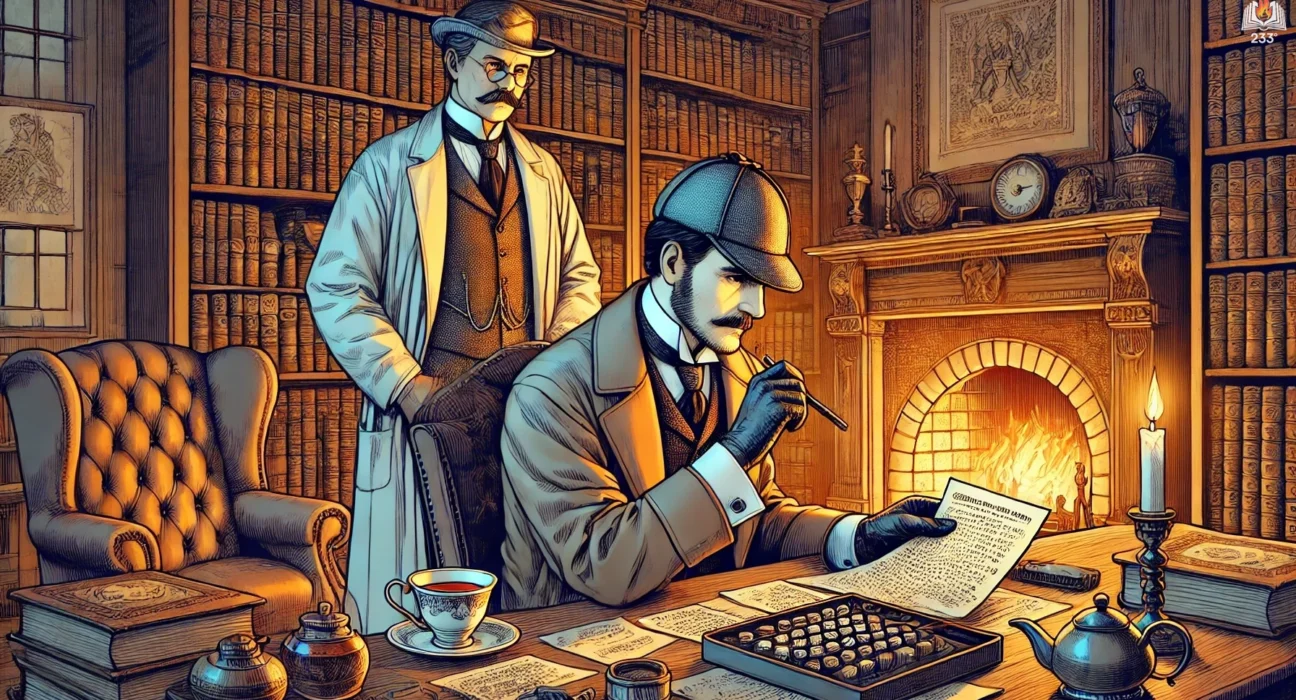The Valley of Fear is a detective novel by Sir Arthur Conan Doyle, first published in 1915. It is the fourth and final full-length Sherlock Holmes novel, and it sees Holmes unraveling a mysterious case involving murder, secret societies, and deception. The novel is divided into two parts: the first focuses on a murder investigation in England, while the second reveals the backstory behind the crime, set in America.
Plot Summary
Sherlock Holmes sat at his breakfast table, staring thoughtfully at a slip of paper that had arrived that morning. Dr. John Watson, ever the curious companion, inquired about it. Holmes revealed it was a message from a man named Porlock, a secretive individual connected to the criminal mastermind, Professor Moriarty. The message, however, was in cipher, and without the key, it was unreadable. Before Watson could express his frustration, another letter arrived, this time from Porlock himself, warning Holmes to abandon the message as the danger was too great. Intrigued, Holmes refused to give up. Soon after, the arrival of Inspector Alec MacDonald of Scotland Yard brought news of a gruesome murder at Birlstone Manor. Holmes knew this could be no coincidence. The game was afoot.
Holmes, Watson, and MacDonald set out for Birlstone Manor, an ancient house surrounded by a moat, where they met Cecil Barker, a close friend of the murdered man, John Douglas. Barker explained that he had discovered Douglas’ body late the previous night. Douglas had been shot at close range with a shotgun, his face nearly obliterated by the blast. A peculiar detail was the open window in the room, though the drawbridge outside had been raised, making it impossible for anyone to leave the manor after the crime. Barker found a card with the initials “V.V. 341” beside the body, adding to the mystery. The situation was perplexing, but Holmes suspected the answer lay not in the obvious but in the hidden layers of the past.
As the investigation deepened, the housekeeper revealed that John Douglas had always been a man of mystery, having arrived in England from America only a few years prior with his wife. His life before that, especially his time in America, was shrouded in secrecy. Although well-liked by the locals, Douglas had always appeared wary, as if expecting some looming danger. His wife, too, had shown signs of nervousness, particularly when her husband was away. It was clear to Holmes that whatever had caused Douglas’ death was connected to this hidden history.
Holmes inspected the scene of the crime with his characteristic attention to detail. The placement of the shotgun, the open window, and the peculiar marks on the windowsill all suggested something unusual. The murder weapon, a sawn-off shotgun, was not commonly found in England, leading Holmes to believe the crime had ties to America, where Douglas had lived much of his life. The missing wedding ring from Douglas’ finger also struck Holmes as a significant clue.
Holmes’ suspicions were soon confirmed when he revealed to Watson and MacDonald that John Douglas had once been a man named Birdy Edwards, a former Pinkerton detective. Years before, Edwards had infiltrated a dangerous American criminal organization known as the Scowrers, who operated in a coal mining region called the Valley of Fear. The Scowrers were a ruthless group, enforcing their own brutal form of justice through violence and murder. Edwards had successfully brought the group down by gathering enough evidence to send their leaders to prison, but this had earned him lifelong enemies. He had fled America, changed his name to John Douglas, and started a new life in England. But the shadow of his past had followed him across the ocean.
The second half of the mystery lay in unraveling how these events led to the murder. Holmes deduced that Douglas had been living in constant fear of retribution. A man named Ted Baldwin, one of the Scowrers whom Douglas had helped convict, had tracked him down to exact his revenge. However, Holmes proposed a daring theory: Douglas had not been killed by Baldwin, but instead had staged his own death to escape this final threat. Baldwin had indeed come to Birlstone Manor to murder Douglas, but in a dramatic turn of events, Douglas had killed Baldwin in self-defense. The gruesome injuries on the body had made identification difficult, allowing Douglas to switch identities with his attacker. With the help of his friend Cecil Barker, Douglas had created the illusion of his own murder.
Holmes’ theory was confirmed when Barker and Mrs. Douglas confessed the truth. John Douglas had survived the attack by Baldwin, but knowing that more men from the Scowrers would come after him, he decided to fake his death and disappear once and for all. The missing wedding ring had been part of this ruse, as Douglas intended to leave behind no personal connection to his former life. Barker, loyal to his friend, had helped carry out the plan, hoping it would buy Douglas the time he needed to flee.
Yet, even as the truth came to light, there was a darker force at play. Holmes was certain that Moriarty, ever the silent puppeteer, had orchestrated Baldwin’s mission to kill Douglas. Moriarty’s vast criminal network was ever-reaching, and though Douglas had escaped for now, the shadow of Moriarty loomed large, as it did over so many of Holmes’ cases.
As Holmes and Watson prepared to leave Birlstone, the detective mused on the nature of the crime. It was a tale not just of murder, but of the long arm of vengeance stretching across time and continents. Though John Douglas had managed to evade his past for a while, the Valley of Fear had never truly let him go.
Main Characters
Sherlock Holmes – The brilliant detective, known for his sharp intellect, deductive reasoning, and a keen sense of justice. In this case, Holmes works to uncover the mystery behind the cryptic warning he receives, which ties into a murder in the English countryside.
Dr. John Watson – Holmes’ loyal friend and chronicler of his adventures, Watson is once again by Holmes’ side, providing a steady presence and serving as the story’s narrator.
John Douglas – The victim of the central murder in the story. He is a mysterious man with a complicated past, having previously lived in America before settling in England. His death sparks the investigation that reveals deep, hidden secrets.
Cecil Barker – A close friend of John Douglas, Barker plays a key role in the investigation. He discovers Douglas’ body and immediately becomes involved in the unfolding mystery.
Inspector Alec MacDonald – A competent and dedicated detective from Scotland Yard, MacDonald assists Holmes in solving the case, showing respect for Holmes’ abilities.
Professor Moriarty – Holmes’ arch-nemesis and the mastermind of a vast criminal network. Although he appears only briefly, Moriarty’s shadow looms over the events, as Holmes suspects his involvement in the case.
Theme
Deception and Hidden Identities – Much of the plot revolves around characters who are not what they seem. The murder mystery itself hinges on the hidden past of John Douglas and the secret lives of several characters.
Justice and Revenge – The novel explores the complex moral terrain between justice and vengeance. As the backstory unfolds, it becomes clear that personal vendettas and retribution drive many of the actions that lead to the murder.
The Influence of Secret Societies – A key element of the novel is the presence of secret societies, particularly in the second part of the book. These organizations exert control and fear over individuals, showing how they manipulate justice and power.
The Power of Intellect – As with many Sherlock Holmes stories, the power of deduction and intellect is a central theme. Holmes’ ability to unravel the most complex of mysteries with his analytical mind is contrasted with the violence and chaos that often surround the cases he solves.
Writing Style and Tone
Sir Arthur Conan Doyle’s writing in The Valley of Fear is as sharp and precise as ever, marked by a clear, methodical tone that mirrors Sherlock Holmes’ logical mind. Doyle uses concise and descriptive language to paint vivid pictures of both the tranquil English countryside and the gritty, dangerous world of secret societies. His writing is rich with suspense, building tension through cryptic clues and startling revelations, keeping readers engaged as Holmes pieces together the mystery.
The tone of the novel is generally serious, with moments of tension and foreboding. The contrast between the calm, analytical demeanor of Holmes and the dark, violent history of the American setting in the second part of the novel creates a gripping atmosphere. There are also subtle hints of humor, often in the interactions between Holmes and Watson, which provide some relief from the darker themes of murder and revenge.
We hope this summary has sparked your interest and would appreciate you following Celsius 233 on social media:
There’s a treasure trove of other fascinating book summaries waiting for you. Check out our collection of stories that inspire, thrill, and provoke thought, just like this one by checking out the Book Shelf or the Library
Remember, while our summaries capture the essence, they can never replace the full experience of reading the book. If this summary intrigued you, consider diving into the complete story – buy the book and immerse yourself in the author’s original work.
If you want to request a book summary, click here.
When Saurabh is not working/watching football/reading books/traveling, you can reach him via Twitter/X, LinkedIn, or Threads
Restart reading!








